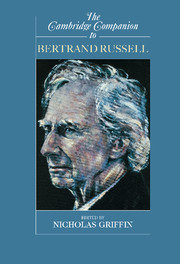Book contents
- Frontmatter
- Introduction
- 1 Mathematics in and behind Russell’s Logicism, and Its Reception
- 2 Russell’s Philosophical Background
- 3 Russell and Moore, 1898-1905
- 4 Russell and Frege
- 5 Bertrand Russell’s Logicism
- 6 The Theory of Descriptions
- 7 Russell’s Substitutional Theory
- 8 The Theory of Types
- 9 Russell’s Method of Analysis
- 10 Russell’s Neutral Monism
- 11 The Metaphysics of Logical Atomism
- 12 Russell’s Structuralism and the Absolute Description of the World
- 13 From Knowledge by Acquaintance to Knowledge by Causation
- 14 Russell, Experience, and the Roots of Science
- 15 Bertrand Russell
- Selective Bibliography
- Index
- Series list
8 - The Theory of Types
Published online by Cambridge University Press: 28 May 2006
- Frontmatter
- Introduction
- 1 Mathematics in and behind Russell’s Logicism, and Its Reception
- 2 Russell’s Philosophical Background
- 3 Russell and Moore, 1898-1905
- 4 Russell and Frege
- 5 Bertrand Russell’s Logicism
- 6 The Theory of Descriptions
- 7 Russell’s Substitutional Theory
- 8 The Theory of Types
- 9 Russell’s Method of Analysis
- 10 Russell’s Neutral Monism
- 11 The Metaphysics of Logical Atomism
- 12 Russell’s Structuralism and the Absolute Description of the World
- 13 From Knowledge by Acquaintance to Knowledge by Causation
- 14 Russell, Experience, and the Roots of Science
- 15 Bertrand Russell
- Selective Bibliography
- Index
- Series list
Summary
introduction
A surprising feature of Russell's work in logic is that he began and ended with a theory of types. This chapter begins with a summary of the 1903 theory of types and then proceeds to the much more complex ramified theory of types that emerged from Russell's intense work on the foundations of logic from 1903 to 1907. After discussing the problems connected with the Axiom of Reducibility, the chapter concludes with the simple theory of types, and the later history of type theory, after the demise of the logicist programme.
the 1903 theory of types
Russell’s early theory of types, presented in Appendix B to the Principles of Mathematics, already contains many of the basic features of the mature system given in his fundamental paper of 1908 and in Principia Mathematica. In 1901, Russell had begun writing out the derivation of mathematics from logic, employing the methods of Peano and his school. This led him to examine Cantor’s proof that there is no greatest cardinal number. This result conflicted with his assumption that there is a universal class, having all objects as members, which ought to have the greatest cardinal number. Close analysis of the diagonal argument used in Cantor’s proof led to the discovery of the paradox of the class of all classes that are not members of themselves, now called “Russell’s paradox,” but which Russell called “the Contradiction.”
The logical paradoxes emerged at an awkward moment, when Russell had already written most of the penultimate draft of the Principles. Rather than hold up its publication indefinitely, he took the manuscript of his book to the printer in May 1902 before finding a solution. His initial reaction was that the Contradiction was of a somewhat trivial character, and that it could be avoided by a simple modification of the primitive propositions of logic.
- Type
- Chapter
- Information
- The Cambridge Companion to Bertrand Russell , pp. 286 - 309Publisher: Cambridge University PressPrint publication year: 2003
- 27
- Cited by



